Cryptococcus species - Study guides, Class notes & Summaries
Looking for the best study guides, study notes and summaries about Cryptococcus species? On this page you'll find 82 study documents about Cryptococcus species.
Page 4 out of 82 results
Sort by
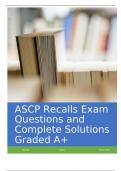
-
ASCP Recalls Exam Questions and Complete Solutions Graded A+
- Exam (elaborations) • 45 pages • 2024
- Available in package deal
-
- $13.49
- + learn more
FFP used for - Answer: Multiple coagulation deficiencies Factor XI deficiency Cryoprecipitate used for - Answer: Replace fibrinogen loss due to DIC Massive bleeding Dysfibrinogenemia with active bleeding Plateletpheresis preparation steps - Answer: Light spin (remove RBC) Heavy spin (spin down PLT and WBC) Supernatant goes into bag for freezing (FFP) Remaining plasma, platelets, and WBC = platelets Irradiated blood prevents - Answer: GVHD Also used for ca...
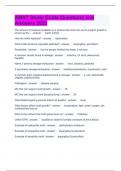
-
AMRT Study Guide Questions and Answers 2023
- Exam (elaborations) • 8 pages • 2023
-
Available in package deal
-
- $19.99
- + learn more
AMRT Study Guide Questions and Answers 2023 The amount of moisture available on a surface that mold can use to support growth is known as the... water activity How do molds replicate? Sporulation What molds produce respirable particles? Aspergillus, penicillium Respirable Can be deeply inhaled into lungs; 5 microns 4 common viruses found in sewage rotavirus, GI virus, adenovirus, hepatitis Name 3 primary sewage biohazards virus, bacteria, parasites ...

-
ASCP Mycology questions and answers
- Exam (elaborations) • 6 pages • 2023
-
Available in package deal
-
- $10.49
- + learn more
ASCP Mycology questions and answers KOH used for skin, hair, nails. Dissolves keratin. Makes fungal elements more visible. Calcoflour white Used for tissues, sputum, BF, skin and corneal scrapings. Fluorescent stain Lactophenol cotton blue Microscopic exam of fungal culture. Lactic acid preserves. Phenol kills. Cotton blue stains. Gram stain Yeast. Fungi stain gram pos Acid-fast Nocardia India ink CSF sediment if Crypotococcus is suspected. Halos around ...
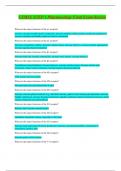
-
USMLE STEP 1 Pharmacology Final Exam Review
- Exam (elaborations) • 88 pages • 2023
-
- $15.00
- + learn more
USMLE STEP 1 Pharmacology Final Exam Review USMLE STEP 1 Pharmacology Final Exam Review What are the major functions of the α1 receptor? Increase vascular smooth muscle contraction, increase pupillary dilator muscle contraction (mydriasis), increase intestinal and bladder sphincter muscle contraction What are the major functions of the α2 receptor? Decrease sympathetic outflow, decrease insulin release, decrease lipolysis, increase platelet aggregation, decrease aqueous humor producti...
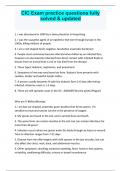
-
CIC Exam practice questions fully solved & updated
- Exam (elaborations) • 19 pages • 2024
-
- $7.99
- + learn more
1. I was discovered in 1894 by a Swiss physician in Hong Kong 2. I was the causative agent of an epidemic that tore through Europe in the 1300s, killing millions of people 3. I am a rod shaped Gram-negative, facultative anaerobic bacterium 4. People most commonly become infected when bitten by an infected flea; however can also become infected from direct contact with infected fluids or tissues from an animal that is sick or has died from the disease. 5. Three types: Bubonic, septicemic, and...
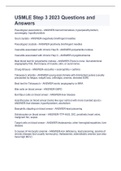
-
USMLE Step 3 2023 Questions and Answers
- Exam (elaborations) • 27 pages • 2023
- Available in package deal
-
- $12.99
- + learn more
Pseudogout associations - ANSWER-hemochromatosis, hyperparathyroidism, acromegaly, hypothyroidism Gout crystals - ANSWER-negatively birefringent needles Pseudogout crystals - ANSWER-positively birefringent needles Vasculitis associated with chronic Hep B - ANSWER-polyarteritis nodosa Vasculitis associated with chronic Hep C - ANSWER-cryoglobulinemia Best blood test for polyarteritis nodosa - ANSWER-There is none. Get abdominal angiography first, then biopsy of muscle, skin, or sur...
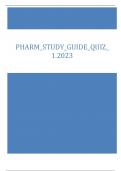
-
PHARM_STUDY_GUIDE_QUIZ_ 1.2023
- Exam (elaborations) • 37 pages • 2023
-
- $17.99
- + learn more
PHARM_STUDY_GUIDE_QUIZ_ 1.2023 1. What are the BON rules and regulations for prescriptive authority for the advance practice nurse? 1. Texas is very restricted 2. Describe the pharmacokinetic processes of absorption, distribution, metabolism and elimination and how differences in these areas affect drug action. 1. Absorption 1. Drug’s movement from the site of administration into the blood. 2. Distribution 1.Drug’s movement from the blood into the interstitial space oftissues and ...
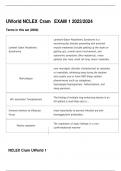
-
UWorld NCLEX Cram EXAM 1 2023/2024
- Exam (elaborations) • 400 pages • 2023
-
- $15.99
- + learn more
UWorld NCLEX Cram EXAM 1 2023/2024 UWorld NCLEX Cram EXAM 1 2023/2024 Terms in this set (2000) Lambert Eaton Myasthenic Syndrome Lambert-Eaton Myasthenic Syndrome is a neuromuscular disorder presenting with proximal muscle weakness (trouble getting up the stairs or getting up), cranial nerve involvement, and autonomic symptoms (like impotence). many patients also have small cell lung cancer classically. Narcolepsy rare neurolgoic disorder characterized by episodes or ...

-
MT ASCP/AMT Final Assessment Exam 300 Questions with Verified Answers,100% CORRECT
- Exam (elaborations) • 65 pages • 2024
-
- $12.99
- + learn more
MT ASCP/AMT Final Assessment Exam 300 Questions with Verified Answers In absorption spectrophotometry: A) Absorbance is directly proportional to transmittance B) Percent transmittance is directly proportional to concentration C) Percent transmittance is directly proportional to the light path length D) Absorbance is directly proportional to concentration - CORRECT ANSWER Absorbance is directly proportional to concentration Which formula correctly described the relationship between ...
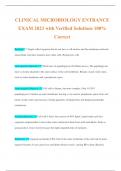
-
CLINICAL MICROBIOLOGY ENTRANCE EXAM 2023 with Verified Solutions 100% Correct
- Exam (elaborations) • 17 pages • 2023
-
- $10.99
- + learn more
CLINICAL MICROBIOLOGY ENTRANCE EXAM 2023 with Verified Solutions 100% Correct Bacteria *** Single-celled organism that do not have a cell nucleus and the membrane-enclosed intracellular structures found in most other cells (Prokaryotic cell). Gram-positive Bacteria *** Thick layer of peptidoglycan (20-80nm across). The peptidoglycan layer is closely attached to the outer surface of the cell membrane. Retains crystal violet stains. Lack an outer membrane and a periplasmic space. Gram-neg...

That summary you just bought made someone very happy. Also get paid weekly? Sell your study resources on Stuvia! Discover all about earning on Stuvia


